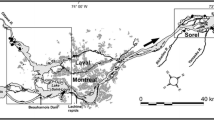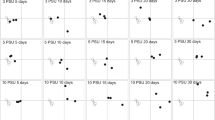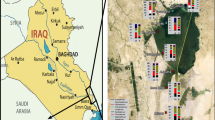Abstract
This paper is the second in a pair investigating potential mechanisms for ecological regime change in salinising wetlands. The first paper in this series focused on the responses of the salt-tolerant submerged macrophyte community to salinity. In this second paper, we investigated some of the environmental conditions required for initiation and dominance of benthic microbial communities using a combination of experimental and observational data. Two experiments were carried out. One investigated the importance of prior establishment of benthic microbial communities on their ability to maintain prevalence over macrophyte colonisation (‘persistence’ experiment), while the other investigated hydrology and its effect on sediment perturbation, potential nutrient release and subsequent benthic microbial community establishment (‘flooding’ experiment). The ‘persistence’ experiment measured the biomass of benthic microbial communities and emergence of macrophytes from sediments kept either wet or dry for 4 weeks then flooded at a range of salinities. Benthic microbial biomass was similar across all of the salinities tested (15, 45 and 70 ppt), with a slight increase at higher salinities, suggesting that none of these limited benthic microbial community development. Pre-wetting of sediments usually increased benthic microbial community biomass and reduced macrophyte germination, but the latter was attributed to the presence of anoxic sediments rather than the increased benthic microbial community biomass. Germinating macrophytes emerged through benthic microbial communities or dense heterotrophic bacterial blooms, demonstrating that they could become dominant even when another community was already established. Field data supported these results, suggesting that the development of benthic microbial communities is not limited by salinity alone, but includes other factors, such as the water regime. In the ‘flooding’ experiment, the largest differences in nutrient concentrations ultimately lay between the pre-wet and pre-dry treatments (due to the greater release of nutrients and development of anoxia in the latter) rather than those subjected to fast versus slow flooding. In response to this, highest benthic microbial community biomass was in treatments with pre-wet sediment, corresponding with lower phytoplankton biomass.
Similar content being viewed by others
References
ANZECC & ARMCANZ, 2000. Australian and New Zealand guidelines for fresh and drinking water quality. Australian and New Zealand Environment and Conservation Council and Agriculture and Resource Management Council of Australia and New Zealand
Australian Greenhouse Office, 2003. Chapter 4. Potential impacts of climate change: Australia. In Pittock B. (ed.), Climate Change: An Australian guide to the science and potential impacts. Available at: http://www.greenhouse.gov.au/science/guide/ Verified 20 October 2004: 84–158
Baldwin D. S. and Mitchell A. M. (2000). The effects of drying and re-flooding on the sediment and soil nutrient dynamics of lowland river-floodplain systems: a synthesis. Regulated Rivers: Research & Management 16: 457–467
Balls H., Moss B. and Irvine K. (1989). The loss of submerged plants with eutrophication I. Experimental design, water chemistry, aquatic plant and phytoplankton biomass in experiments carried out in ponds in the Norfolk Broadland. Freshwater Biology 22: 71–87
Bauld J. (1981). Occurrence of benthic microbial mats in saline lakes. Hydrobiologia 81: 87–111
Bauld J. (1986). Benthic microbial communities of Australian saline lakes. In: Williams, W. D. (eds) Limnology in Australia, pp 95–111. CSIRO and Dr W. Junk Publishers, Melbourne, Australia and Dordrecht, The Netherlands
Beklioglu M. and Moss B. (1996). Existence of a macrophyte-dominated clear water state over a very wide range of nutrient concentrations in a small shallow lake. Hydrobiologia 337: 93–106
Bjornsson, K. T., B. Ostendorf & F. Recknagel, 2003. Using wetland nutrient modelling to estimate River Murray and floodplain wetland water exchange. In Post D. A. (ed.), MODSIM 2003 International Congress on Modelling and Simulation, July 2003, Vol. 1. Modelling and Simulation Society of Australia and New Zealand, Canberra., Townsville, 404–409
Blindow I., Andersson G., Hargeby A. and Johansson S. (1993). Long-term pattern of alternative stable states in two shallow eutrophic lakes. Freshwater Biology 30: 159–167
Boulton A. J. and Brock M. A. (1999). Australian Freshwater Ecology. Processes and Management. Gleneagles Publishing, Glen Osmond, South Australia
Brock M. A. (1982). Biology of the salinity tolerant genus Ruppia L. in saline lakes in South Australia. I. Morphological variation within and between species and ecophysiology. Aquatic Botany 13: 219–248
Brock M. A. and Lane J. A. K. (1983). The aquatic macrophyte flora of saline wetlands in Western Australia in relation to salinity and permanence. Hydrobiologia 105: 63–76
Brock M. A. (1986). Adaptation to fluctuations rather than to extremes of environmental parameters. In: Williams, W. D. (eds) Limnology in Australia, pp 131–140. CSIRO and Dr W. Junk Publishers, Melbourne, Australia and Dordrecht, The Netherlands
Brock, T. D. & M. T. Madigan, 1991. Chapter 19. The bacteria. In The Biology of Microorganisms (6th edn.). Prentice-Hall, Inc., Englewood Cliffs, NJ, USA, 703–716
Burke C. M. and Knott B. (1989). Limnology of four groundwater-fed saline lakes in south-western Australia. Australian Journal of Marine and Freshwater Research 40: 55–68
Burke C. M. and Knott B. (1997). Homeostatic interactions between the benthic microbial communities and the waters of a hypersaline lake, Lake Hayward, Western Australia. Marine and Freshwater Research 48: 623–631
Casanova M. T., Douglas-Hill A., Brock M. A., Muschal M. and Bales M. (1997). Farm ponds in New South Wales, Australia: relationship between macrophyte and phytoplankton abundance. Marine and Freshwater Research 48: 353–360
Castenholz R. W. (1994). Microbial mat research: the recent past and new perspectives. In: Stal, L. J. and Caumette, P. (eds) Microbial Mats. Structure, development and Environmental Significance, pp 3–18. Springer-Verlag, Berlin, Heidelberg, Germany
Clesceri L. S., Greenberg A. E. and Eaton A. D. (1999). Standard Methods for the Examination of Water and Wastewater. American Public Health Association, Washington DC, USA
Cohen Y. (1989). Preface. In: Cohen, Y. and Rosenberg, E. (eds) , Microbial Mats. Physiological Ecology of Benthic Microbial Communities, pp xv–xvii. American Society for Microbiology, Washington, DC, USA
Costerton J. W. and Stoodley P. (2003). Preface. Microbial biofilms: protective niches in ancient and modern geomicrobiology. In: Krumbein, W., Paterson, D. and Zavarzin, G. (eds) Fossil and Recent Biofilms. A Natural History of Life on Earth, pp xv–xxi. Kluwer Academic Publishers, Dordrecht, The Netherlands
Davis J., McGuire M., Halse S., Hamilton D., Horwitz P., McComb A., Froend R., Lyons M. and Sim L. (2003). What happens when you add salt: predicting impacts of secondary salinisation on shallow aquatic ecosystems using an alternative states model. Australian Journal of Botany 51: 715–724
Davis, J. A., 2004. Valleys of salt, channels of water, pools of life – environmental aspects of salinity engineering. In Proceedings of the 1st National Salinity Engineering Conference, Perth, Western Australia
Davis J. S. (1978). Biological communities of a nutrient enriched salina. Aquatic Botany 4: 23–42
(1983). Australian salt lakes: their history, chemistry and biota – a review. Hydrobiologia 105: 231–244
Casanova M. T. and Clayton J. S. (2004). Charophyte germination and establishment under low irradiance. Aquatic Botany 79: 175–187
García A. and Chivas A. R. (2004). Quaternary and extant euryhaline Lamprothamnium Groves (Charales) from Australia: gyrogonite morphology and paleolimnological significance. Journal of Paleolimnology 31: 321–341
George R. J., McFarlane D. J. and Speed R. J. (1995). Chapter 2. The consequences of a changing hydrologic environment for native vegetation in southwestern Australia. In: Saunders, D. A., Craig, J. L., and Mattiske, E. M. (eds) Nature Conservation 4: The Role of Networks, pp 9–22. Surrey Beatty & Sons, Chipping Norton, New South Wales
Guerrero M. C. and Tadeo A. B. (1994). Environmental factors controlling the development of microbial mats in inland saline lakes; the granulometric composition of the sediment. In: Stal, L. J. and Caumette, P. (eds) Microbial Mats. Structure, Development and Environmental Significance, pp 85–90. Springer-Verlag, Berlin, Heidelberg, Germany
Halse S. A., Ruprecht J. K. and Pinder A. M. (2003). Salinisation and prospects for biodiversity in rivers and wetlands of south-west Western Australia. Australian Journal of Botany 51: 673–688
Hatton T. J., Ruprecht J. and George R. J. (2003). Preclearing hydrology of the Western Australia wheatbelt: target for the future?. Plant and Soil 257: 341–356
Johnson K. S. (1982). Determination of phosphate in seawater by flow injection analysis with injection of reagent. Analytical Chemistry 54: 1185–1187
Johnson K. S. (1983). Determination of nitrate and nitrite in seawater by flow injection analysis with injection of reagent. Limnology and Oceanography 28: 1260–1266
Kühl M., Fenchel T. and Kazmierczak J. (2003). Chapter 5. Growth, structure and calcification potential of an artificial cyanobacterial mat. In: Krumbein, W., Paterson, D., and Zavarzin, G. (eds) Fossil and Recent Biofilms. A Natural History of Life on Earth, pp 77–102. Kluwer Academic Publishers, Dordrecht, The Netherlands
Kushner D. J. (1993). Microbial life in extreme environments. In: Ford, T. E. (eds) Aquatic Microbiology. An Ecological approach, pp 383–407. Blackwell Scientific Publications, Boston, USA
Lassen C., Revsbech N. P. and Pedersen O. (1997). Macrophyte development and resuspension regulate the photosynthesis and production of benthic microalgae. Hydrobiologia 350: 1–11
Levit G. S. and Krumbein W. E. (2003). Chapter 22. Is there an adequate terminology of biofilms and microbial mats?. In: Krumbein, W., Paterson, D. and Zavarzin, G. (eds) Fossil and Recent Biofilms. A Natural History of Life on Earth, pp 333–341. Kluwer Academic Publishers, Dordrecht, The Netherlands
Moss, B., 1967a. A note on the estimation of chlorophyll a in freshwater algal communities. Limnology & Oceanography 12: 340–342
Moss, B., 1967b. A spectrophotometric method for the estimation of percentage degradation of chlorophylls to pheo-pigments in extracts of algae. Limnology & Oceanography 12: 335–340
Moss B. (1990). Engineering and biological approaches to the restoration from eutrophication of shallow lakes in which aquatic plant communities are important components. Hydrobiologia 200/201: 367–377
Pedrós-Alió, C. & R. Guerrero, 1994. Protokaryology for the limnologist. In Margalef R. (ed.), Limnology Now: A Paradigm Of Planetary Problems. Elsevier Science, 37–57
Qiu S. and McComb A. J. (1995). Planktonic and microbial contributions to phosphorus release from fresh and air-dried sediments. Marine and Freshwater Research 46: 1039–1045
Qiu S. and McComb A. J. (1996). Drying-induced stimulation of ammonium release and nitrification in reflooded lake sediment. Marine & Freshwater Research 47: 531–536
Scheffer M. (1990). Multiplicity of stable states in freshwater systems. Hydrobiologia 200/201: 475–486
Scheffer M. (1998). Ecology of Shallow Lakes. Kluwer Academic Publishers, Dordrecht, The Netherlands
Sim L., Davis J. A. and Chambers J. M. (2006a). When is it too salty for saline wetlands? Conceptual models for the examination of ecological regime shifts in saline wetlands. Verhandlungen Internationale Vereinigung für theoretische und angewandte Limnologie 29: 1679–1682
Sim, L. L., 2005. Transitions between ecological regimes in salinising wetlands. In School of Environmental Science. Murdoch University, Murdoch, Western Australia
Sim, L. L., J. A. Davis & J. M. Chambers, 2006b. What evidence exists for alternative ecological regimes in salinising wetlands? Freshwater Biology 51: 1229–1248
Sim, L. L., J. M. Chambers & J. A. Davis, 2006c. Ecological regime shifts in salinised wetland systems. I. Salinity thresholds for the loss of submerged macrophytes. Hydrobiologia DOI 10.1007/s10750-006-0267-0
Sørensen K. B., Canfield D. E. and Oren A. (2004). Salinity responses of benthic microbial communities in a solar saltern (Eilat, Isreal). Applied and Environmental Microbiology 70: 1608–1616
Strehlow K., Davis J., Sim L., Chambers J., Halse S., Hamilton D., Horwitz P., McComb A. and Froend R. (2005). Temporal changes between ecological regimes in a range of primary and secondary salinised wetlands. Hydrobiologia 552: 17–31
Switala K. (1993). Determination of Ammonia by Flow Injection Analysis Colorimetry (Dialysis). Latchet Instruments, Milwaukee, USA
Takahashi M. and Ichimura S. (1970). Photosynthetic properties and growth of photosynthetic sulfur bacteria in lakes. Limnology and Oceanography 15: 929–944
Valderrama J. (1981). The simultaneous analysis of total nitrogen and total phosphorus in natural waters. Marine Chemistry 10: 109–122
Welsh D. T. and Herbert R. (1994). Panel discussion: colonisation and early development of microbial mat communities. In: Stal, L. J. and Caumette, P. (eds) , Microbial Mats. Structure, Development and Environmental Significance, pp 131–132. Springer-Verlag, Berlin, Heidelberg, Germany
Wetzel R. G. (1983). Limnology. Saunders College Publishing, Philadelphia, USA
Author information
Authors and Affiliations
Corresponding author
Rights and permissions
About this article
Cite this article
Sim, L.L., Davis, J.A. & Chambers, J.M. Ecological regime shifts in salinised wetland systems. II. Factors affecting the dominance of benthic microbial communities. Hydrobiologia 573, 109–131 (2006). https://doi.org/10.1007/s10750-006-0268-z
Received:
Revised:
Accepted:
Published:
Issue Date:
DOI: https://doi.org/10.1007/s10750-006-0268-z




